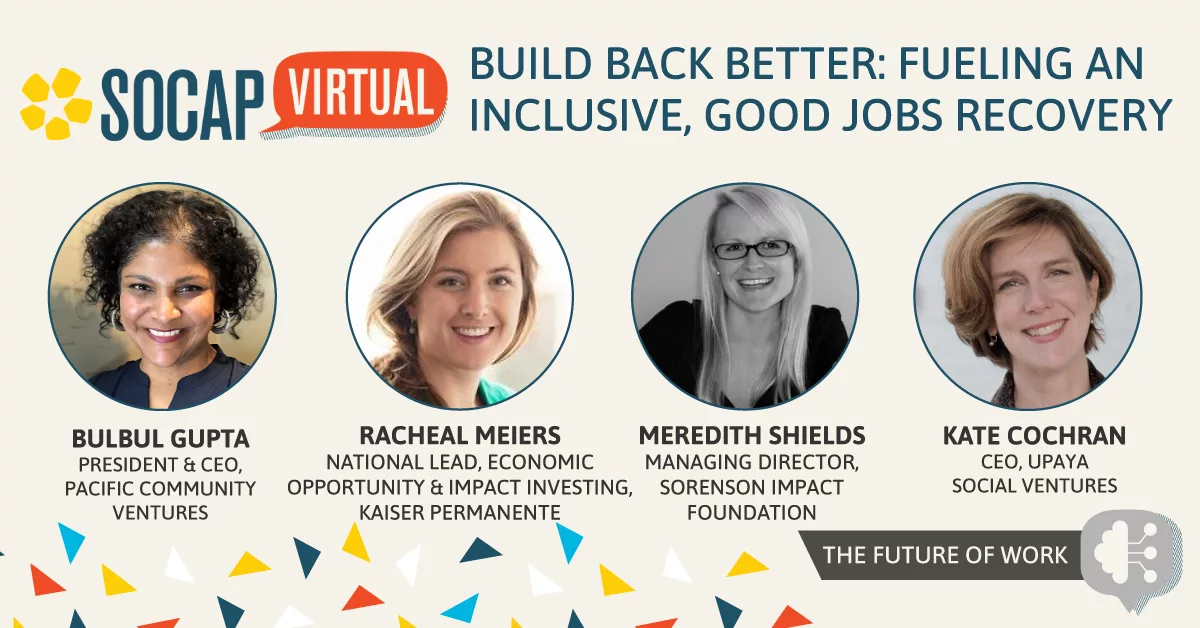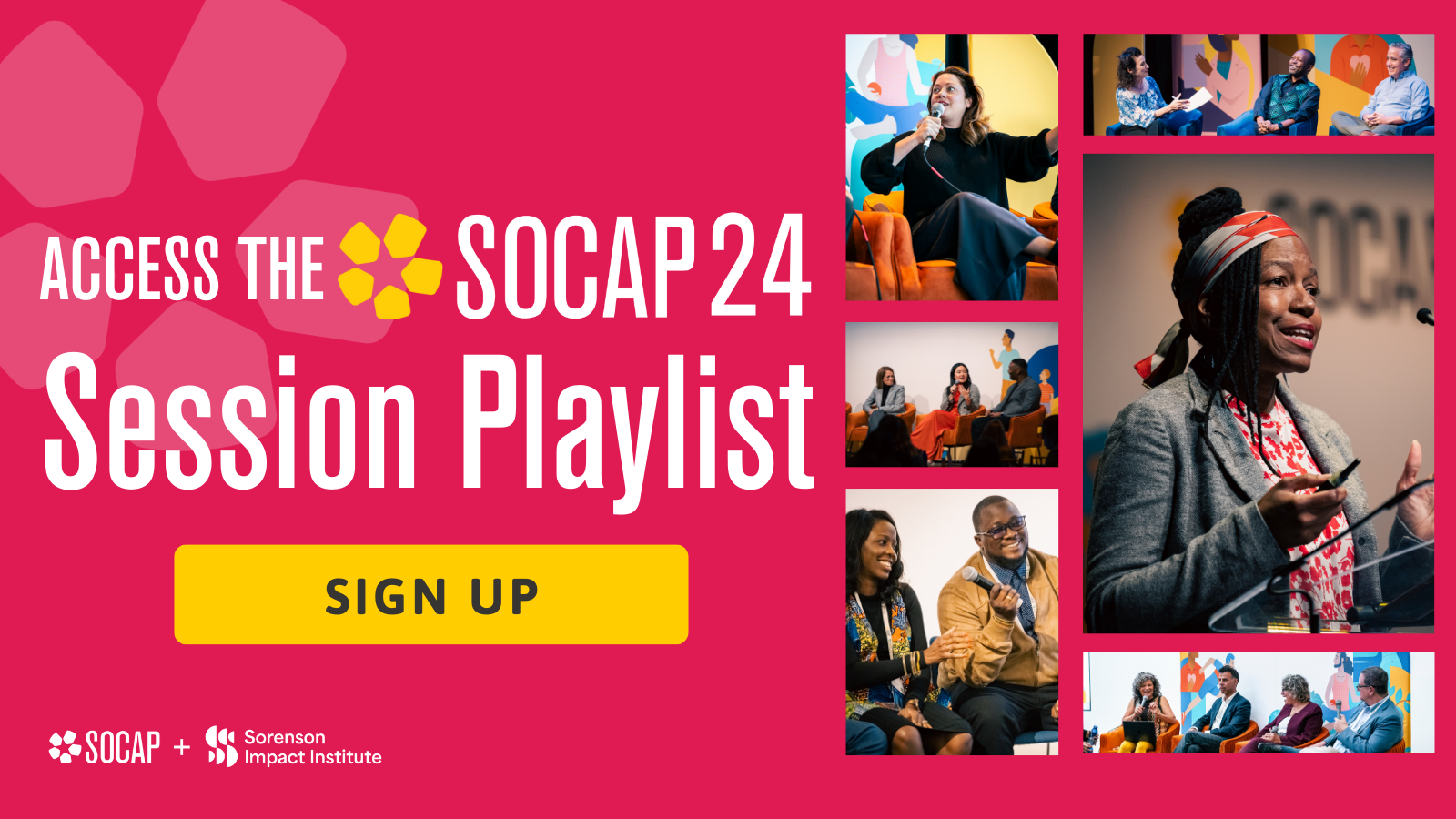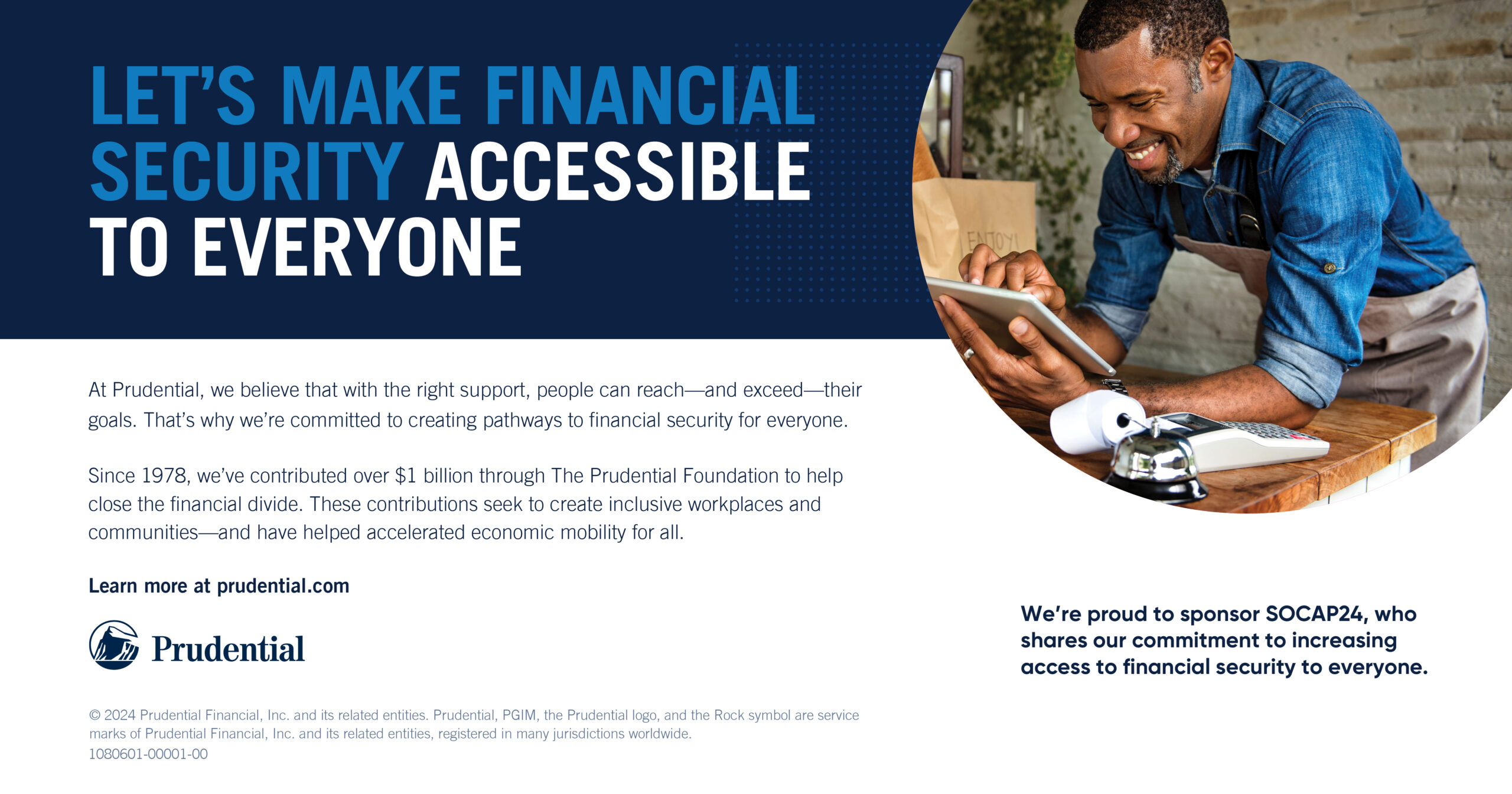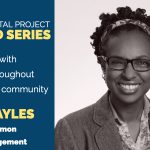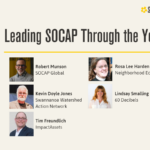The Importance of Inclusive, Good Job Recovery
Impact investors and social entrepreneurs today must be intentional about creating good jobs. We must ensure that this recovery fuels the small and growing businesses that can create the next 500 million jobs—dignified jobs, with good wages in both the United States and developing countries.
In this conversation, originally recorded as part of SOCAP Virtual 2020, investors whose mission is to stimulate economic development for underserved communities share actionable guidance on defining good jobs, supporting workforce development, and building businesses that create economic opportunity. Watch the full session — or read excerpts from the conversation — below.
Speakers:
- Kate Cochran, CEO at Upaya Social Ventures
- Bubul Gupta, CEO at Pacific Community Ventures
- Meredith Shields, Managing Director at Sorenson Impact Foundation
- Racheal Meiers, National Lead of Economic Opportunity and Impact Investing at Kaiser Permanente
Watch Build Back Better: Fueling An Inclusive, Good Jobs Recovery
Kate Cochran: I think that many of us experienced the Great Recession of 2008 and 2009, and the thing about the Great Recession is that the recovery that followed has been known as a “jobless recovery,” and it has led to some of the most damaging economic inequality that has been seen in modern history. And as we sit here in 2020, we have a chance to do better. And that’s what this panel is going to be about. And we have wonderful investors and capacity builders and industry leaders to talk about their work in ensuring that economic opportunity is shared more broadly in the recovery. And so before I invite them to share their thoughts, I’ll just give you a little bit of an introduction to myself.
I run a nonprofit organization called Upaya Social Ventures. We invest in early-stage companies in India for the purpose of creating jobs for the extreme poor. So I obviously have a very strong point of view on this. But when we make our investments, we don’t just take the entrepreneur’s word for it that they’ve created X number of jobs and leave it at that. We follow up and we do interviews and we make sure that those job holders are actually seeing meaningful income increases and that they are seeing more reliability and stability in their jobs. And that they’re able to purchase assets, they are beginning to send children to school, the kinds of things that are the hallmarks of dignity in a job. And those are the kinds of things we would like to talk about today.
Our first panelist, Bubul Gupta, last year stepped into a role at Pacific Community Ventures as CEO, leading an organization that has really been leading the charge on good jobs for a long time. So Bubul, why don’t we turn things over to you to start our round of introductions?
Bubul Gupta: Thanks, Kate. I am exactly a year into the CEO role at Pacific Community Ventures as Kate mentioned, which is a 22-year old CDFI, Community Development Financial Institution, based in California. We provide affordable capital to small and growing businesses throughout the state of California. But we also do a couple of other things.
We’re unique both as a CDFI and as a nonprofit because we also have two programs that really are meant to address the needs of not just small businesses largely led by entrepreneurs of color who have been rejected by the formal financial industry, which is why CDFIs like us were created 30 years ago, but also who have a hard time filling the access to mentorship gaps. So we’re really trying to play both roles, in many cases, mimicking the VC industry by being able to provide the right kind of capital and the right kind of mentorship network to help with the pre-and post-investment support that we know under-invested small business owners need.
And our third line of business is our impact-investing research and consulting practice. Internally for us, that team helps make sure that as impact investors we are not only measuring our own impact. That team was the one that really designed for us the good jobs framework a few years ago, which brings us into an ability to not only work with our own small business owners on where are they on a good jobs journey when they come into us, but also, how do we help them year over year being able to get the right kind of capital, the right kind of advisor, financial advisor and others as they need them to stay on the good jobs journey with us to make impact and focus on the journey?
That same team helps us internally measure whether our portfolio is increasingly addressing the racial and gender wealth gaps and contributing to community wealth building that we really want to be contributing to in our integrated model. And then they also work externally with other foundations and impact investors.
We know that people of color, for example, especially women of color, start more businesses in the U.S. than any other one demographic— 600% more so in the last few years. This has been led by black women starting small, small businesses in many cases. And we are working on helping them create the kinds of jobs that can really lift the floor and be good quality jobs, dignified jobs. We really want to be part of the solution when we’re thinking about investing in low-wealth communities or communities of color. CDFIs like us, some of you may know, have a mandate to invest at least 60% of their capital and more into low- and moderate-income communities.
And in PCV’s case, I’m really proud of the fact that last year we ended with over 87% of our capital invested in low and moderate income communities and 80% of our capital into women and entrepreneurs of color specifically. Something we’re that much more committed to advancing certainly this year and even more so as we see how the crisis is really particularly played out particularly for entrepreneurs of color in the US. I will save a little bit more beyond the intro in that regard, but really lovely to be here and part of this conversation.
Meredith Shields: I’m with the Sorenson Impact Foundation, which is a family foundation based in Salt Lake City, Utah, and was founded by Jim Sorenson. We were founded by an entrepreneur. And for that reason, almost 100% of what we do is support entrepreneurs in the impact space. We invest in impact investments both through our program’s dollars, 5% of the foundation that goes out as program-related investments or grants, and we also invest out of the other 95%. So we are a foundation that is 100% invested in impact investments across everything from public equities to early stage entrepreneurs around the world.
We are a global investor, so we’re active on five continents right now. We support companies that are providing access to health care, access to education. And I think what’s important about us for this conversation is that as an investor, oftentimes the largest expense item when you’re looking at an income statement is salaries and benefits. And for us as an impact investor, we take a multistakeholder approach. For each company that we invest in, we think about not just the beneficiaries of the products and services that our investments are producing, but also the types of jobs that are created, the income and earning potential, as well as the development and up-skilling or re-skilling opportunities that are being provided by the companies. And as an investor and an impact investor, we believe that this yields better-performing portfolio companies and much higher impact overall.
Rachael Meiers: I’ll jump right in. I lead our economic opportunity and impact investing programs at Kaiser Permanente. We are the nation’s largest integrated health system, we have over 12 million members to whom we provide health care and coverage in multiple states. Obviously, our principal concern is to support the health of our members and to provide really good quality and affordable health care.
But we’ve learned, I think along with the rest of the health care community, that a lot of what impacts on people’s health happens far outside of the health care setting. And so we sort of call that the upstream determinants of health, we’ve now come to call it social health. An integral part of that is economic opportunity, people’s ability to earn an income and build wealth over time. Those have obviously direct impacts on housing stability and food security, which are very directly related to health as well as many other factors. So related tothis panel, we do know that good jobs specifically really matter for health. We see that unemployment increases a number of adverse health outcomes, increases mortality rates.
And then sort of on the flip side, in the U.S., people’s health benefits and their access to health care is often tied to employment. And so unemployed people are also less likely to have safe and affordable access to health care. We see good jobs as sort of important for individuals and just their sense of self-worth and their ability to maintain their health as well as their ability to access health care. We have a number of different ways that we’re working to support good jobs that hopefully we’ll be able to share today.
Cochran: Thanks, all. Let me kick off first with a question for Bubul. Obviously, we are all experiencing different kinds of challenges in 2020 and with COVID. For the particular kind of work that you’re doing, describe the kinds of challenges you’ve experienced this year and how you’ve overcome them?
Gupta: Thanks for asking. Where to start? So we work directly with small businesses throughout the state of California. As I said, many of them are minority businesses. And we saw very early when the shelter-in-place orders started, we knew that the bulk of our businesses didn’t have more than one to two months of runway to survive. So we tried really hard to start activating capital, our own existing funders, new funders, just trying to raise the alarm for folks who may or may not be directly connected with small business communities. We saw, for example, with the federal stimulus package that when you design a process from the top down, that inherently leaves out the entire industry of CDFIs that were created to serve that community that big banks are not good at serving because of the systemic discrimination and redlining that we’ve had in the industry for many years. That even when they included CDFIs in the second round, it was too late for many small businesses and they were still disconnected from some of the larger CDFIs that were pulled in who might be SBA lenders and have the kinds of assets under management that were allowed to participate but may or may not have the direct connection with the small business owners, especially founders of color who wouldn’t even qualify for SBA lending.
Overall, we have kept our lending available, we have connected folks with other lenders. We work a lot to connect anybody who reaches out to us with our business advising platform so that even if they can’t get an immediate yes for capital, they can at least work with a financial advisor maybe to refinance or a marketing advisor to pivot online, reach customers directly just to be able to keep even partial revenues going because that can be a make or break for a lot of small businesses.
Just being able to keep some partial revenues going also allows them to stay eligible for capital in the following months. We’ve already seen almost 50% of Black-owned small businesses in California alone go under. And it is about 27%, I think, nationally. About 33% of Latinx-owned small businesses in California have already gone under, according to the June NBER reports. We’ve seen spikes in our lending capital of over 20X in the spring when the shelter-in-place orders started, over 5X on our business advising team.
We were really lucky this summer to be able to work with Kaiser and Rachel’s team to be able to scale up the business-advising platform to be able to offer that to more Black and entrepreneurs of color nationwide, because that is such an important piece of mentorship. We’ve also worked really hard in the state of California with the Governor’s office and a group of other CDFIs, Kiva, some capital providers to be able to come together on the California Small Business Rebuilding Fund, which is meant to provide some capital to the entrepreneurs who may or may not have gotten PPP support but could really use some capital to stay afloat. And similar to the New York and Chicago funds that launched earlier this, we expect that fund to be oversubscribed within two days.
We’re really trying to raise as much affordable capital into CDFIs as possible to be able to keep our doors and others CDFI’s doors open for the entrepreneurs we know need us, especially as we anticipate and are hearing more and more about some additional COVID spikes coming this winter. The ripple effect business closures have in our local communities and the culture of our local communities, it’s really, really hard to come back. Once you close a business, most businesses never reopen.
And lastly, I will just say that we already saw half of generational Black wealth wiped out in the Great Recession. We are very much on the brink of that right now. So if we do not see more affordable capital provided through CDFIs who are best positioned to be able to reach these communities, we’re really seeing how that impact is going to play out all over again. And frankly, a lot of foundations, corporates are still on the sidelines. They’re still trying to reassess or figure out, is more government support coming, where is my support needed? Some of them may have acted in the immediate crisis. Some of them returned calls after the George Floyd murder happened, but many of them honestly have not still gotten off the sidelines. And we need people to get off the sidelines and help, whether it is grant capital, whether it’s affordable capital, lending PRIs. There’s a big effort to engage HalfMyDAF that folks have launched, but it’s really all hands on deck.
adrotate group=”7″]
Cochran: I’d like to ask Meredith, I know the Sorenson Impact Foundation moved very quickly at the beginning of the crisis to bring together other investors and to look to provide capital to these kinds of companies that were fostering economic opportunity. What was your thinking beyond that? And how are you thinking about when we move beyond crisis and into recovery?
Shields: On top of deploying capital to our own portfolio companies to keep them going, we reached out to other investors in our network. And we’re excited to learn of a number of coalitions, as well as Village Capital quickly launched a digital solution called Abaca that brings together investors around social entrepreneurs and small businesses through the growth stage actually around the world. We jumped into both of those feet first and started contributing our pipelines. So any deal that we saw, we tried to get those companies to also put themselves on these platforms. And then we tried to find a way to share our research. So we had our team out there presenting almost like they were presenting our investment committee pitch to other investors around the world, whoever would dial in.
And we view that as a way to somewhat efficiently attract more capital to the entrepreneurs who needed it most and in a time of crisis. And so Kate, you asked, how do we see that going forward even when we’re past the crisis? And I want to talk about inclusion for a second, because one great thing about the way that we’ve been working through the crisis is that I think organizations have been more open to sharing, more open to asking, “Hey, what other deals are you seeing? What can we bring together since we’re all limited right now by the virtual environment?”
And by and large, the feedback I’m hearing is that that’s opening organizations to broader access to different types of deal flow, different types of entrepreneurial networks and resources. And so my hope is that through this more collaborative approach, through these more high level deal aggregating resources like Abaca that we can start to democratize access. Taking away that veil about how to get money when you’re starting a business is something that we’ve seen work fairly well during the crisis, and we’d like to keep that going in the future.
Meiers: To pick up on the theme of kind of being able to move quickly as we started to see what was happening at the start of the pandemic, we made a pretty significant commitment in late June of this year, our CEO announced $100 million towards addressing racial equity and promoting economic opportunity in our communities. And so as part of our collaboration with PCV, we also have a pretty significant partnership with LISC. We have a $60 million investment partnership that we’ve both contributed $30 million into. And that investment comes from our corporate treasury. That was actually years in the making, and we were just able to activate it this summer. In that collaboration, we also have a grant aspect to that. It’s looking at investing in businesses responding to the crisis, but it was designed prior to the crisis. And it is looking at recovery and really centering job growth and neighborhood wealth in recovery.
We have one piece of that that I just wanted to share today, which is the Good Jobs Fund. And it’s a $20 million impact debt fund that offers flexible financing to small businesses that are intentionally bringing quality jobs. And so it’s very focused on supporting minority-owned businesses, but it is mid-level businesses that are major job creators that have also demonstrated a commitment to job quality. So we’ve looked at deals. We have a conversation with a call center business that’s looking at expanding into different cities. They have sort of a growth mentality of taking over sort of failing malls like Retail Blight and converting those into call center facilities. They have a very strong commitment not only to hiring from sort of untapped talent pools and underserved communities but also to providing really good wages and just amazing supports to their employees like home ownership programs and things like this.
We’re also looking very deeply at our own hiring practices, recognizing that health care is a career. Especially an organization like ours, we’re very committed to our labor partnerships, most of our workforce is unionized. We’re really looking at, how do we find individuals that are underemployed or unemployed in our communities and help track them into some of the more entry-level jobs that can then get them on a path to advancement in healthcare and to a better stable career? And we also do the same thing with our business partners.
One sort of COVID-related story is, I’m sure everybody heard about the personal protective equipment supply chain issues. And we had relationships in L.A., we had commitment among a lot of our business leaders. They built a partnership with apparel factories in L.A. to create masks and gowns and a number of other things that we needed for our personal protective equipment and to save those jobs in L.A. So we have built a lot of institutional commitment to these issues that sort of stretches across the different ways that we engage our communities.
Cochran: When you talk about the investments you’ve made that are specifically thinking about quality jobs, does Kaiser have a point of view about what are the elements of a quality job, what you’re looking for?
Meiers: We like PCV’s framework, that’s part of the reason we’re working with them. We definitely believe in family-sustaining wages, we believe that jobs should provide benefits, they should provide sick leave. We have some work we do on the policy side that encourages cities to adopt sick leave policies. We I think sort of would check the boxes that you would see anybody tick, and we judge ourself against the same criteria.
Gupta: Our Good Jobs Framework is our online toolkit for small business owners, with micro-actions even pre-crisis. We launched this internally after years of research on, what does it mean to have a quality job in America? Launched it in 2016 as a piece of research, and then user tested it within our own lending portfolio. Got some feedback from our own entrepreneurs and launched it online just a year ago.
Now, given the crisis that we have, we are not only trying to keep people on the good jobs journey for those that continue to grow, but really also play a jobs preservation and impact preservation agenda as much as we can. So with whatever grant capital we can raise to be able to beef up those micro-grants within our lending to a meaningful enough small grants program, especially for a lot of our entrepreneurs of color who need affordable capital even more so who maybe weren’t reached enough by PPP or other programs yet to be able to just hang onto their business and hang on to as many jobs as they can.
We’re doing this in a couple of ways. One is raising, I was talking about affordable capital earlier to really be able to launch a little bit more of a small grants program, especially within California, and to be able to pair with our lending capital. We’re doing this by also working with some of the other Black-led CDFIs.
And when we think about our underwriting as an investment into these small business owners, we already saw pre-crisis that entrepreneurs of color when we were doing our underwriting in the last couple of years tend to under-report things like personal assets. We have been really innovative and playing with our lending criteria to be able to make sure that we are not being unintentionally punitive. When we think about sort of systemic change to be able to show up with the kind of capital and have the kind of outcome through our small business owners as agents of change, being able to invest even better with a whole entrepreneur approach that’s a little bit closer to character-based lending was really important for us to get to so that we’re not looking at a minimum credit score, we’re not looking at the tight credit boxes that fintechs or banks tend to look at because our whole design is to reach the community that gets rejected by banks, SBA, and even in many cases fintechs that have a tighter credit box and look for a higher minimum credit score than we do.
Really thinking deeply about if we want to invest better and better in entrepreneurs of color and if we want to have the kind of community wealth building and racial wealth gap outcomes through them through creating good quality jobs, what are we doing up and down our policies and our work to really make sure that we are doing the systems change we need to do within our organization and within our industry? And being able to better and better communicate that with stakeholders, especially this year to be able to try to keep some of those jobs and as many of those jobs and families supported as we can.
Cochran: Meredith, do you want to comment about sort of how you think about embedding your values into your investing?
Shields: When we say we’re impact investors, it’s interesting because you look at term sheets and oftentimes you don’t see the impact in the term sheet. It’s the financial terms laid out the same way that any other investor looks at a deal. And we wanted to explore that and think through, how do we create some accountability in an achievable way that’s supportive to entrepreneurs? Creating incentives to have a multi-stakeholder approach. Especially when it comes to jobs and employees, I think that if you’re focused on the wrong area, that can become an expense to reduce not an asset to leverage.
What we did in the one deal is, so this company organizes artisans in India and provides them with skills development and access to supply chain and lots of coaching and mentoring so that they can increase their income through aggregated sale of their products to retailers around the world. And when we started looking at the company, we liked the fact that they had really impressive, not only number of jobs that they were creating, so upwards of 1,000 every year that they’d been operating, it’ll reach almost 2,000 this year. But also the income increase was really impressive.
So far this year, the artisans who’ve been working with the group have increased their income by over 23% in a fairly short period of time. So we said, “Okay, great, we’re so happy to see that.” So the key deal terms in our term sheets, so the discount rate and the valuation cap are actually on a little grid that’s front and center in the term sheet. And the rate that they get is more beneficial to the entrepreneur if they’re overachieving on the impact side. So if the benefit to the artisans who are by and large their employees is increasing over time. And so we felt like that was one way that we can act with impact at the forefront of what we’re doing, but also align everybody’s incentives so that the company is incentivized to continue to develop so that they produce better products that generate more revenue. That one was a no-brainer solution for us. And so far, they’re tracking, and they’re doing really well.
